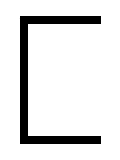|
Lydian Script
Lydian script was used to write the Lydian language. Like other scripts of Anatolia in the Iron Age, the Lydian alphabet is based on the Phoenician alphabet. It is related to the East Greek alphabet, but it has unique features. The first modern codification of the Lydian alphabet was made by Roberto Gusmani in 1964, in a combined lexicon, grammar, and text collection. Early Lydian texts were written either from left to right or from right to left. Later texts all run from right to left. One surviving text is in the bi-directional boustrophedon manner. Spaces separate words except in one text that uses dots instead. Lydian uniquely features a quotation mark in the shape of a right triangle. Alphabet The Lydian alphabet is closely related to the other alphabets of Asia Minor as well as to the Greek alphabet. It contains letters for 26 sounds. Some are represented by more than one symbol, which is considered one "letter." Unlike the Carian alphabet, which had an ''f'' derived fro ... [...More Info...] [...Related Items...] OR: [Wikipedia] [Google] [Baidu] |
Lydian Language
Lydian (𐤮𐤱𐤠𐤭𐤣𐤶𐤯𐤦𐤳 ''Sfardẽtiš'' " anguageof Sardis") is an extinct Indo-European Anatolian language spoken in the region of Lydia, in western Anatolia (now in Turkey). The language is attested in graffiti and in coin legends from the late 8th century or the early 7th century to the 3rd century BCE, but well-preserved inscriptions of significant length are so far limited to the 5th century and the 4th century BCE, during the period of Persian domination. Thus, Lydian texts are effectively contemporaneous with those in Lycian. Strabo mentions that around his time (1st century BCE), the Lydian language was no longer spoken in Lydia proper but was still being spoken among the multicultural population of Kibyra (now Gölhisar) in southwestern Anatolia, by the descendants of the Lydian colonists, who had founded the city. Text corpus and decipherment In 1916 the Sardis bilingual inscription, a bilingual inscription in Aramaic and Lydian allowe ... [...More Info...] [...Related Items...] OR: [Wikipedia] [Google] [Baidu] |
Sabellian Language
The Osco-Umbrian, Sabellic or Sabellian languages are an extinct group of Italic languages, the Indo-European languages that were spoken in Central and Southern Italy by the Osco-Umbrians before being replaced by Latin, as the power of Ancient Rome expanded. Their written attestations developed from the middle of the 1st millennium BC to the early centuries of the 1st millennium AD. The languages are known almost exclusively from inscriptions, principally of Oscan and Umbrian, but there are also some Osco-Umbrian loanwords in Latin. Besides the two major branches of Oscan and Umbrian (and their dialects), South Picene may represent a third branch of Sabellic. The whole linguistic Sabellic area, however, might be considered a dialect continuum. Paucity of evidence from most of the "minor dialects" contributes to the difficulty of making these determinations. Relationship with the Italic languages Following an original theory by Antoine Meillet, the Osco-Umbrian languages were tr ... [...More Info...] [...Related Items...] OR: [Wikipedia] [Google] [Baidu] |
Carian Alphabets
The Carian alphabets are a number of regional scripts used to write the Carian language of western Anatolia. They consisted of some 30 alphabetic letters, with several geographic variants in Caria and a homogeneous variant attested from the Nile delta, where Carian mercenaries fought for the Egyptian pharaohs. They were written left-to-right in Caria (apart from the Carian–Lydian city of Tralleis) and right-to-left in Egypt. Carian was deciphered primarily through Egyptian–Carian bilingual tomb inscriptions, starting with John Ray in 1981; previously only a few sound values and the alphabetic nature of the script had been demonstrated. The readings of Ray and subsequent scholars were largely confirmed with a Carian–Greek bilingual inscription discovered in Kaunos in 1996, which for the first time verified personal names, but the identification of many letters remains provisional and debated, and a few are wholly unknown. The Carian alphabet resembles the Greek alphabet, bu ... [...More Info...] [...Related Items...] OR: [Wikipedia] [Google] [Baidu] |
Runic Letter Fehu
Runes are the letters in a set of related alphabets known as runic alphabets native to the Germanic peoples. Runes were used to write various Germanic languages (with some exceptions) before they adopted the Latin alphabet, and for specialised purposes thereafter. In addition to representing a sound value (a phoneme), runes can be used to represent the concepts after which they are named (ideographs). Scholars refer to instances of the latter as ('concept runes'). The Scandinavian variants are also known as ''futhark'' or ''fuþark'' (derived from their first six letters of the script: '' F'', '' U'', '' Þ'', '' A'', '' R'', and '' K''); the Anglo-Saxon variant is ''futhorc'' or ' (due to sound-changes undergone in Old English by the names of those six letters). Runology is the academic study of the runic alphabets, runic inscriptions, runestones, and their history. Runology forms a specialised branch of Germanic philology. The earliest secure runic inscriptions date from ar ... [...More Info...] [...Related Items...] OR: [Wikipedia] [Google] [Baidu] |



